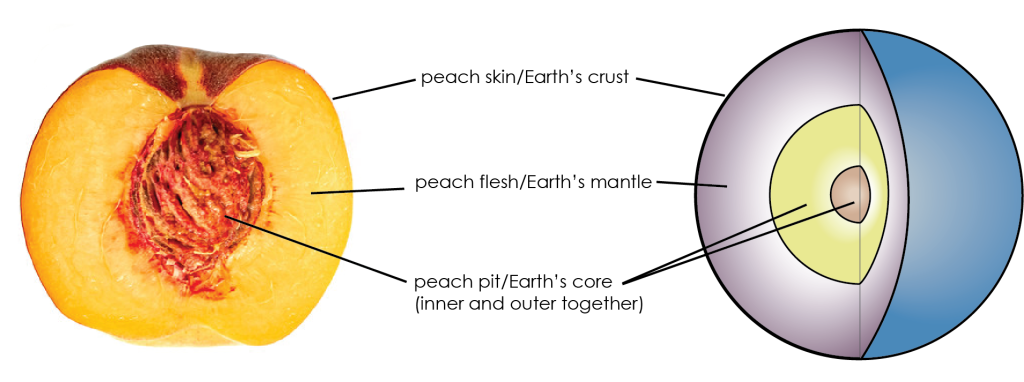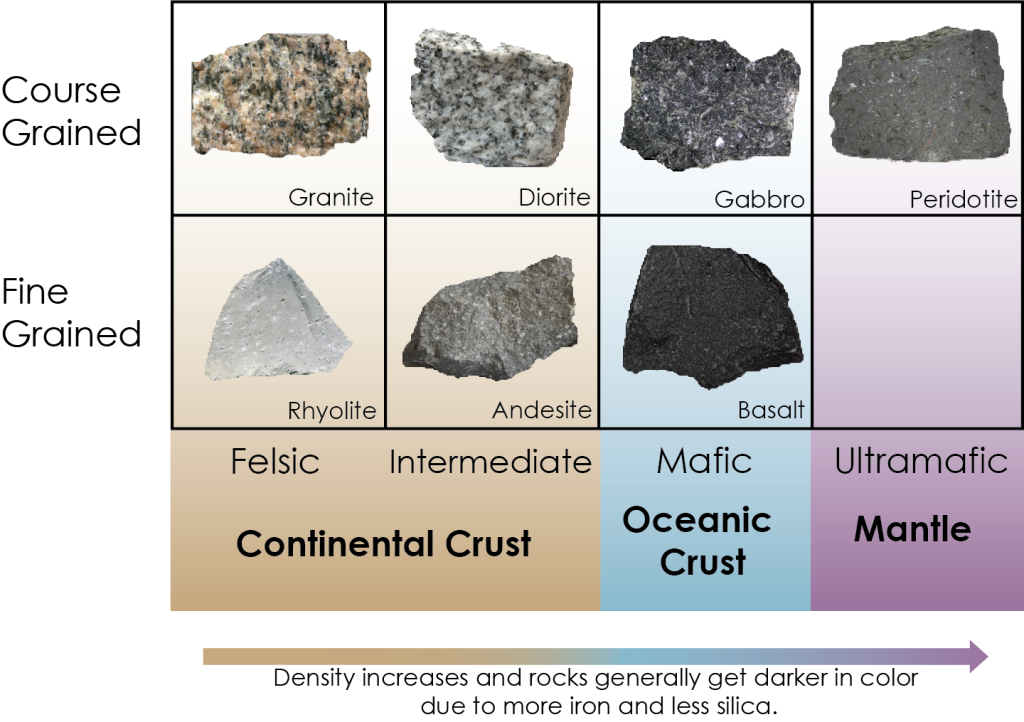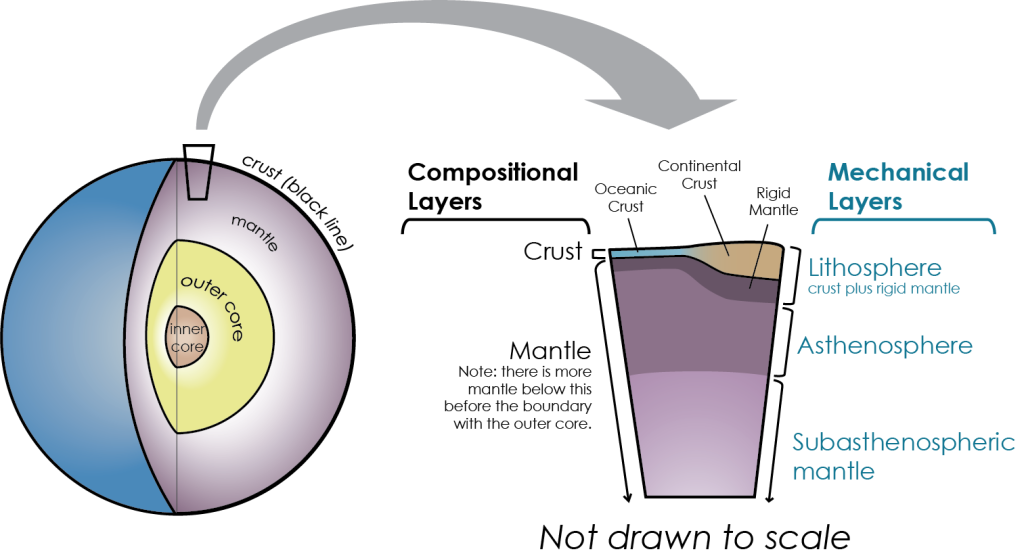1. Earth’s Layers: Compositional and Mechanical
The theory of plate tectonics was revolutionary in geology; it changed the way we think about and understand the Earth and its processes. It explains the interconnectedness of earthquakes, volcanoes, mountains belts, and many other features. For geologists, this revolution in thinking is akin to well-known examples in biology such as Charles Darwin’s 1859 book on evolution, On the Origin of Species, or the discovery of the double helix structure of DNA by James Watson, Francis Crick, and Rosalind Franklin in 1953. But the key to understanding plate tectonics and all that it explains, is understanding Earth’s internal structure, or layers.
Earth is divided into two different sets of layers. One set is based on the chemical makeup (composition), of the rocks/materials in the layers and the other set is based on how those rocks behave (mechanics). These two ways of talking about Earth’s layers are related to each other, but they are not the same layers.
1.1 Compositional Layers
Earth consists of three main compositional layers: the crust, the mantle, and the core, which is divided into the outer core and the inner core. These layers are based on chemical composition and organized by density, with layers getting progressively denser moving from Earth’s exterior toward the interior. In other words, the inner core is the densest material, and the crust is the least dense.
The core (inner and outer together) accounts for almost half of Earth’s radius, but it amounts to only 16.1% of Earth’s volume. Most of Earth’s volume (82.5%) is its mantle, and only a small fraction (1.4%) is its crust. An analogy for the relative thicknesses of these layers would be the layers of a peach, where the peach skin is the crust, the flesh is the mantle, and the pit is the core (Figure 1A.1.1). Earth’s rocky exterior (the only part we ever see, and we can’t even drill all the way through it) is actually very thin!

Crust
The Earth’s outermost layer, its crust, is rocky and rigid. There are two kinds of crust: continental crust, and oceanic crust. Continental crust is thicker, averaging about 30km in thickness but can be as deep as 100km thick underneath large mountain belts. It is predominantly felsic and intermediate in composition, meaning that the rocks contain minerals that are richer in silica. The composition is important because it makes continental crust less dense than oceanic crust. These composition names are given to igneous rocks (those solidified from molten rock – magma or lava – and make up the bulk of Earth’s crust and mantle). Figure 1A.1.2 below shows the standard organization of igneous rocks from felsic to ultramafic composition and aligns this with the appropriate compositional layers of Earth.
Ocean crust is thinner at only 5-10km in thickness. It is predominantly mafic in composition. Mafic rocks contain minerals with less silica, but more iron and magnesium. Mafic rocks (and therefore oceanic crust) are denser than the rocks of continental crust (Figure 1A.1.2).
The crust floats on the layer below it, the mantle. Being less dense, continental crust floats higher in the mantle than oceanic crust, allowing it to reach above sea level. Whereas oceanic crust floats lower and is below sea level – hence the names of these two types of crust!
An important consequence of the difference in density is that if tectonic plates happen to bring oceanic crust and continental crust into collision, the plate with ocean crust will be forced down into the mantle beneath the plate with continental crust.
Check Your Understanding: Continental vs. Oceanic Crust
Mantle
The layer below the crust is the mantle. The mantle is almost entirely solid rock, but it is in constant motion, flowing very slowly. It is ultramafic in composition, meaning it has even more iron and magnesium than mafic rocks, and even less silica (Figure 1A.1.2). Although the mantle has a similar chemical composition throughout, it has layers with different mineral compositions and different physical properties. It’s possible for rocks to have different mineral compositions and still be the same in chemical composition because the increasing pressure deeper in the mantle causes mineral structures to be reconfigured. Rocks higher in the mantle are typically composed of peridotite (this is the rock shown in Figure 1A.1.2).
Ah! So many new words! Here is some help…
To put the diagram below into context, this chart is a simplified representation of the igneous rock classification chart. Igneous rocks are classified based on two things: 1. texture (grain size) and 2. the minerals present.
The rows in Figure 1A.1.2 are grain size. Igneous rocks are classified as either coarse-grained (can see individual minerals with your eyes) or fine-grained (need a microscope to see individual minerals).
Igneous rock forming minerals solidify/crystallize from molten rock in very specific orders, which means certain minerals tend to show up together in rocks, while other sets of minerals will never be together. But there are a couple minerals that will cross those boundaries and be part of multiple groups.
Think of this like a terribly clique-y high school – the band kids hang out with other band kids and the jocks hang out with the jocks, but there is still the jock who also just loves to rock out on their trumpet and so is part of both groups. (Why the trumpet? I don’t know…why not?)
These “cliques” of minerals make up the different mineral composition groups of felsic, intermediate, mafic, and ultramafic. These are the columns in Figure 1A.1.2.
Based on these two factors, a name can then be given to the rock. So, a fine-grained rock with felsic composition is called rhyolite. If the same felsic composition was present, but instead the rock was coarse-grained it would get a different name and be called granite.
The details of the minerals present in the different compositions are beyond the scope of this textbook, but understanding the relationship of the compositions to density and Earth’s layers is important. This figure is color coded to match the layer coloring in the other figures to help you make this connection. This knowledge will show up again during discussions of plate tectonic boundaries and volcanic eruptions.

Core
In the center of the Earth is the core. Unlike the crust and mantle the core is not rock, instead it is metallic. It is composed of iron-nickel alloy. It has two layers to it, the outer core, which is liquid iron and nickel and the inner core, which is solid iron and nickel (Figure 1A.1.3). The core is extremely hot: ~3500°C to more than 6000°C. Yet despite the fact that the boundary between the inner and outer core is approximately as hot as the surface of the sun, only the outer core is liquid. The inner core is solid because the pressure at that depth is so high it keeps the core from melting. (Note: At these temperatures, if you could somehow bring a sample of the core to Earth’s surface without it cooling off, it would vaporize instantly and eventually rain solid droplets of very hot metal onto you. So, maybe not a good idea.).
This difference between the liquid and solid states of the outer and inner cores, respectively, plays a key role in how seismic waves (earthquake waves) transmit through the Earth. Incidentally, using seismic waves to “see” inside the Earth is how we gained much of our information about Earth’s internal structure. This is discussed more in the chapter on earthquakes.
1.2 Mechanical Layers
The mechanical layers of the Earth are based on their mechanical properties (i.e., how the layers behave). This behavior is not directly aligned to the composition, but rather connected to a combination of composition, pressure, and temperature and therefore is different from the compositional layers but will be discussed in terms of their relationship to the compositional layers.
Lithosphere
The lithosphere is the outermost mechanical layer that behaves like solid, brittle rock (from the Greek lithos meaning stone and sphere meaning globe or ball). It consists of crust and the uppermost layer of the mantle. This portion of the mantle is technically called lithospheric mantle but also gets referred to as the rigid mantle, the rigid upper mantle, the uppermost mantle, etc. (throughout this textbook, rigid mantle will be used). The rigid mantle is relatively cool compared to the rest of the mantle and therefore behaves more like the brittle, rocky crust than like the rest of the slow flowing mantle. So compositionally, it is like the rest of the mantle, but in behavior it is like the crust and is functionally “stuck” to the underside of the crust.
The lithosphere averages 80km thick, although it varies based on whether it is under oceans and volcanically active areas (thinner in these locations) or under large mountain belts where the continental crust is thicker (then the lithosphere is also thicker). The lithosphere is divided into large fragments that contain the oceans and continents of the planet. These fragments are the “plates” of Plate Tectonics Theory.
Asthenosphere
Beneath the lithosphere is the asthenosphere. The asthenosphere is entirely mantle, although only in the upper portion of the mantle as there is still plenty of mantle below the asthenosphere layer (Figure 1A.1.3). The asthenosphere extends from the base of the lithosphere to approximately 410km deep. The remainder of the mantle below this can be referred to as the subasthenospheric mantle.
Tiny amounts of melted rock are dispersed through the otherwise solid asthenosphere making the asthenosphere weak, or soft, compared to the lithosphere (asthenes meaning weak in Greek) and able to flow slowly. The weakness of the asthenosphere is important for plate tectonics because it deforms as fragments of lithosphere move over and through it. Without a weak asthenosphere, the lithosphere plates would be locked in place, unable to move as they do now. Note that even though the asthenosphere does have tiny amounts of melt, it is still a solid.

Tip for interpreting diagrams with Earth’s layers:
Because oceanic crust is thinner than continental crust, in figures like the one above, oceanic crust will always be drawn as a thinner layer than continental crust. So even if the two types of crust did not have labels and different colors (blue for oceanic, brown for continental), the visual clue of thicker vs. thinner crust is enough to know which one is continental vs. oceanic.
Check Your Understanding: Compositional vs. Mechanical Layers
Check Your Understanding: Diagram of Earth’s layers
Check Your Understanding: Earth’s Layers Analogy (this one is a bit more challenging!)
